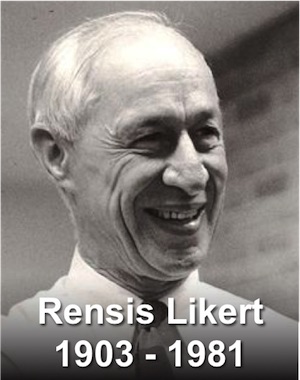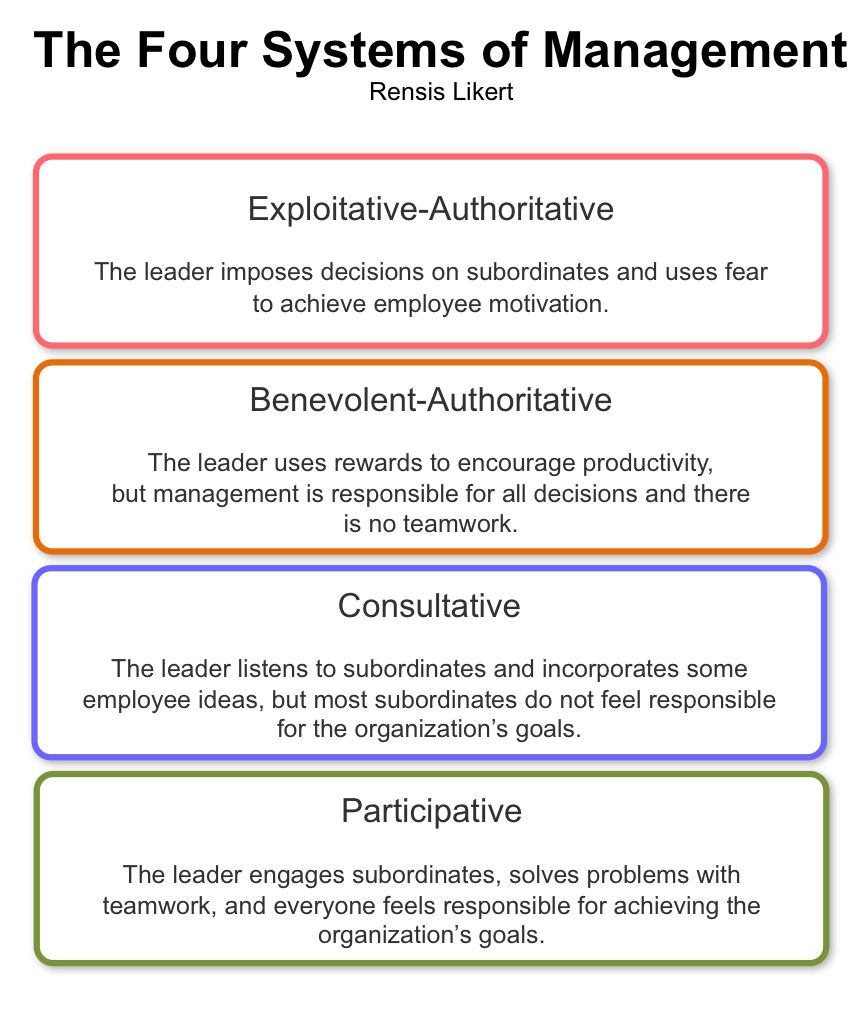Rensis Likert made an important contribution to management in the 1960s, which was to influence many large corporations in the US and Japan. Do you:
a. Strongly Disagree – b. Disagree – c. Neither Agree nor Disagree – d. Agree – e. Strongly Agree
Almost all of us have, at some time, had to use this type of simple perceptual scale. It is called a Likert Scale, after Rensis Likert, who invented it early in his career. But there is more to him than that, as we shall see.

Short Biography
Rensis Likert was born in 1903, in Cheyenne, Wyoming. In 1922, he went to study Civil Engineering (following his father) at the University of Michigan. However, during a Sociology class in his senior year, he realised he was more interested in people than in things, so switched subject and won his bachelors degree in Sociology and Economics, in 1926. In 1932, he was awarded a PhD for research in the new field of Social Psychology, by Columbia University. As a part of his research he developed a simplified scale for gauging opinions, which bears his name today. His research demonstrated that, despite its simplicity, it was able to achieve equally reliable results, when compared with more sophisticated approaches.
Likert then took on a series of increasingly important roles: lecturer in psychology at New York University, Director of Research at the Life Insurance Agency Management Association, and then in 1939, he became a Director responsible for surveys at the U.S. Department of Agriculture. Gradually his role in Government surveys expanded, and during the US involvement in the Second World War, he headed up a part of the Office of War Information.
After the war, Government contracted and surveys were no longer mandated by Congress. So Likert, along with his colleagues sought to establish a centre for reseach into surveys at one of the universities. In 1946, they settled at the University of Michigan and founded the Survey Research Center with Likert as its first Director. The centre changed its name in 1949 to the Institute for Social Research (ISR) and has grown and thrived ever since. Likert remained Director until his retirement in 1970, when his co-founder, Angus Campbell, became the second ISR Director.
During the 1950s and 60s, Likert directed his research interest towards management. His 1961 book, New Patterns of Management, proved highly influential. It introduced his four systems of management and articulated his advocacy for ‘System 4‘. He followed this, in 1967, with Human Organization: Its Management and Value. This further detailed System 4, and contains his most widely quoted statement:
‘…the greater the loyalty of the members of a group toward the group, the greater is the motivation among the members to achieve the goals of the group, and the greater is the probability that the group will achieve its goals.’
In 1970, he established his consulting business, Rensis Likert Associates, to capitalise on his thinking, and he also continued to develop and publish his ideas. His 1976 book, New Ways of Managing Conflict, was also very successful.
Rensis Likert died in September 1981.
Likert’s Four Management Systems
Likert articulated four styles of management. We can easily see these as an extension of the Theory X / Theory Y approaches that Douglas McGregor articulated.

The four systems are:
System 1. Exploitative-Authoritative
Decision-making takes place at the top of the organization and these decisions are imposed on others without consultation. There is little sense of teamwork and not much communication, other than threats, which form the primary means of driving performance (motivation). Consequently, it is only upper management who feel any sense of responsibility for the organisation’s goals.
System 2. Benevolent-Authoritative
This is a patriarchal, patronising system based on a master-servant relationship between management and employees. Rewards are the motivators and teamwork, communication, and a sense of ownership of the organisation’s goals are still minimal.
System 3. Consultative
In this style, managers trust subordinates but not wholly. They motivate with both rewards and involvement, and expect a higher level of responsibility for meeting goals. There is a moderate amount of teamwork and some communication across and between levels.
System 4. Participative
Participative management is based on trust and confidence in employees. Goals are determined collectively and form a basis for motivation and rewards. This fosters a collective sense of responsibility for meeting company goals, and incentivises collaborative teamwork and open communication.
The Characteristics of Likert’s System 4
Likert felt strongly that System 4 was the optimum system for managing an organisation, as McGregor argued for Theory Y as a means of motivating individuals.
He set out four principal characteristics of successful System 4 management:
- Supportive group relationships, both within the group and between the group members and the leader. A sense of care and collaboration.
- Each person’s individual contribution, needs, value, and development needs to be equally respected.
- The group undertakes problem solving together, and aligns behind their eventual consensus solution.
- Different groups overlap, with certain individuals playing the role of ‘linking pin’ between them. These are people whom Karen Stephenson refers to as ‘Gatekeepers’.
This all has a very modern feel to it and it is hard to feel the sense of novelty Likert’s ideas had in the 1960s. This, I suggest, is a measure of the importance of Likert’s ideas. So I choose Option e. Strongly Agree.
